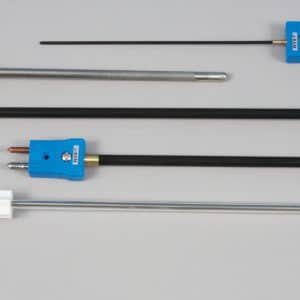J-KEM Thermocouple FAQs
Thermocouple FAQs
For those who are not as familiar with this tool, we’ve provided a short list of thermocouple FAQs. These questions are geared towards those who are newer to the world of science. For those who have more advanced questions in regards to our thermocouples, or just thermocouples in general, please reach out to us at (314) 863-5536.

What Is A Thermocouple?
A thermocouple (also commonly called a probe) is a temperature measuring device. They look like a stick or a wire connected to a colored two-pronged or four-pronged plug.
How Do Thermocouples Work?
Thermocouples work by having two kinds of metal connected that react to heat differently in such a way that a tiny electric current is generated. Measuring this current in context provides the information to determine the temperature.
Only the tip of the probe is required to be in contact with your solution to read temperature.
Why Are There Different Kinds Of Thermocouples?
Different kinds of thermocouples have different ranges of temperatures they measure; the difference in them is caused by using different combinations of metals.
What Are Some Different Kinds Of Thermocouples?
Types of metal available: Stainless Steel, Iconel, Hastelloy
Types of coatings: FEP Teflon (Not for use above 200° C), Glass (up to 600°C), Not Coated
Diameters: 1/16″, 1/4″, 1/8″
Lengths: Just ask
Can I Bend it?
Yes.
Grounded or Ungrounded?
Stock thermocouples are ungrounded.
Is An RTD Considered A Thermocouple?
No, an RTD is not a thermocouple. It’s a stick-like sensor that measures temperature. It uses resistance (hence RTD: Resistance Temperature Detector) rather than an electric current. Instead of two different metals, there’s a pure metal wire (usually platinum) wrapped around a ceramic or glass core. It has a high degree of accuracy for temperatures under 600° C.
What Size/Color Thermocouple Works For What?
- J [black] works for temperatures between 0 – 800° C. The two metals in a J are iron and constantan, a copper-nickel alloy.
- K [yellow] works for temperatures between -50 – 1200° C. The two metals in a type K are chrome (a nickel-chromium alloy) and alumel (a nickel, manganese, aluminum and silicon alloy).
- T [blue] works for temperatures between -200 – 250° C. The two metals in a type T are copper and constantan.
You will want to make sure that all the items in your set up are the same thermocouple type. (Controller, probe, connecting cable).